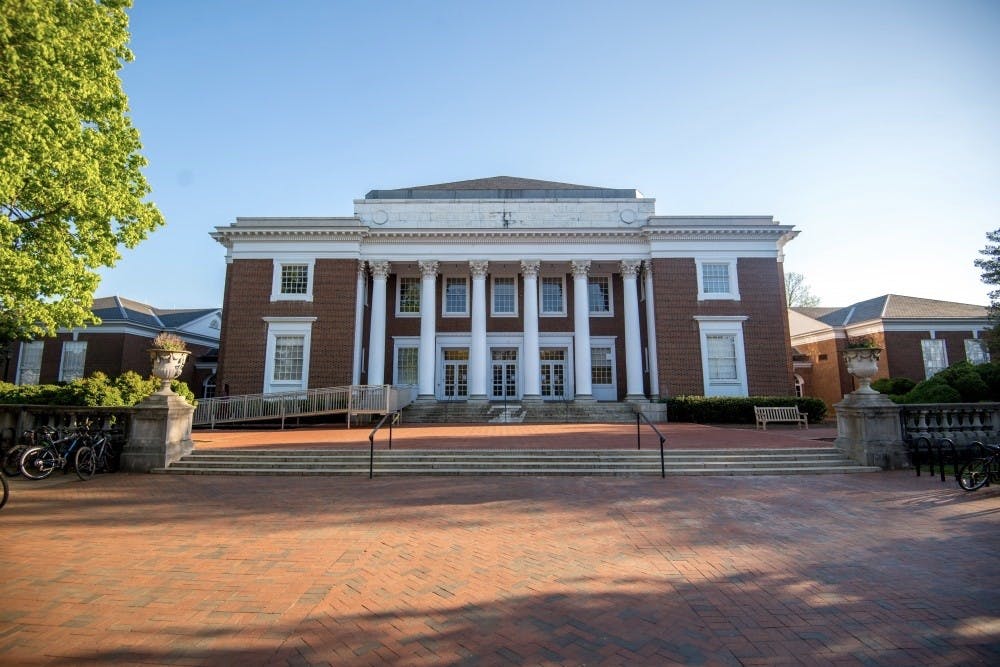At the Virginia Topology Conference this past weekend, experts explored geometry and the dynamics of hyperbolic spaces. The event was hosted by the University Friday through Sunday in Clark Hall.
The conference was organized by Assoc. Mathematics Prof. Thomas Koberda and Asst. Mathematics Prof. Sara Maloni, as well as Filippo Mazzoli and Mark Pengitore, mathematics research associates and lecturers. The National Science Foundation awarded a research and training grant for geometry and topology to the University’s mathematics department to assist in funding the conference. The conference has occurred nearly every year at the University since 2015, with the exception of its cancellation last year due to the COVID-19 pandemic.
Topology is the study of properties that remain the same throughout continuous deformation, such as stretching or twisting. For instance, a donut and a tea cup are equivalent in the world of topologists, as a donut can be stretched and shaped into the form of a tea cup. Hyperbolic geometry — which is different from the Euclidean geometry that most students study in school — and dynamics were chosen as the specific focus topics of the conference this year because of interconnectivity between these areas and many other branches of mathematics, including number theory and arithmetic geometry.
Maloni explained that discussion of these related fields provided faculty and graduate students with a new way to look at their subjects.
“Sometimes you can hear an idea that is connected to what you are doing, and is possibly an idea for new research,” Maloni said. “By talking with the person, you realize a connection, and using two different sets of skills you might be able to answer these open questions.”
The conference began Friday afternoon with lectures covering the subject of arithmetic manifolds. More lectures followed Saturday, which covered a variety of topics important to the field of topology and dynamics — such as the dynamics of dilation surfaces and circle packings. The day was capped with a banquet providing opportunities for networking and further discussion between the attendees and lecturers over dinner.
The conference concluded Sunday morning with two final talks on Lie groups and invariant polynomials, setting the stage for the Virginia Mathematics Lectures — a three-day annual series that follows the conference from Monday to Wednesday. This year, the annual series features Fields Medalist Curtis T. McMullen and focuses on his research in geometry and dynamics.
McMullen won the 1998 Fields Medal for his work in geometry and dynamical systems. The medal is one of the highest honors awarded in the field of mathematics. McMullen said he is eager to explain his work, and mathematics in general, to others.
“I like explaining things, even when I have to work through them myself at the same time,” McMullen said in an email statement to The Cavalier Daily. “I like talking about math — one on one, in a small class, in a lecture. I enjoy it when I can interact with [students] or a class or a colleague, and have some back and forth.”
The research that won Curtis McMullen the Fields Medal incorporated ideas from a variety of different fields in mathematics.
“I am as much an analyst as a geometer,” McMullen said. “My personal choice has always been to follow my curiosity, and learn from others — usually I don’t ‘jump into’ a totally new field, but I often move towards adjacent fields or bring new methods to problems that can be viewed from many perspectives.”
McMullen is not the only one who believes math problems should be viewed from multiple perspectives.
Spencer Martin, co-president of the Undergraduate Math Club and fourth-year College student, led a meeting before the conference Tuesday in which he gave a pre-lecture to students on some of the subject areas covered in the conference and VML series. Martin noted that one benefit of the guest speakers was to offer new perspectives on what they learned in class or their own research.
“In math, you often get very familiar with a certain perspective on a type of object, but there are so many different ways of looking at the same thing,” Martin said.
Even for those not as familiar with the subjects covered, Maloni believes that the conference and subsequent lecture series can serve as a way to spark new directions in research as well as an opportunity for undergraduates to ask questions and seek one-on-one interaction with experts in the field. Maloni also hopes that the lectures will enhance students' curiosity and help foster a mathematical community.
“Although U.Va. might be our first or second academic home, academia is so much larger than just one school,” Martin said. “Guest lectures serve as a good reminder of this, and offer the opportunity to connect with people outside our immediate circles here.”
While the particular interests of those at the events diverged in some ways, the thread they all share is an appreciation for abstract ideas and mathematical beauty.
“I was attracted by mathematics, in large part, by my curiosity about infinity,” McMullen said.
Additionally, Maloni said she sees parallels between mathematics and art.
“There are a lot of connections between geometry and art,” Maloni said. “I like when I see patterns, when I see more abstract ways to explain what is going on.”
The VML series began Monday with McMullen’s work on finding roots to polynomial equations of the fifth degree. During Tuesday's lecture, McMullen discussed the dynamics of billiards. On Wednesday night, the events will come to a close with a final lecture by McMullen on one of the main topics of the conference and series — hyperbolic spaces and geometry.
CORRECTION: The editing process on the original version of this article resulted in an inaccurate reference to Prof. Maloni. The reference has been corrected.







